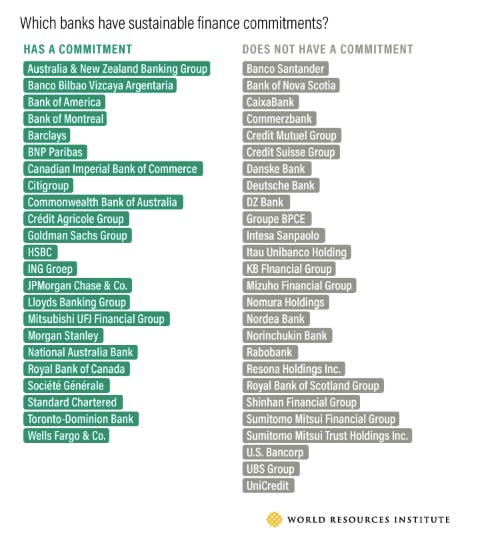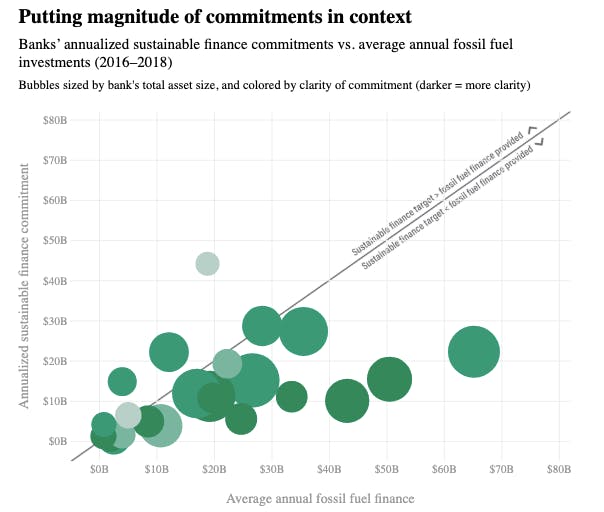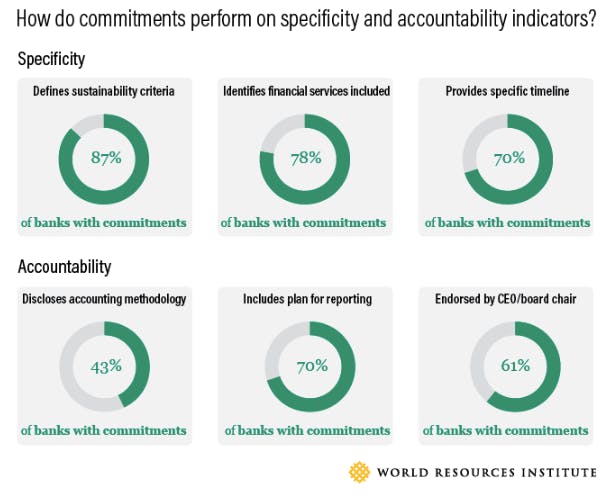Private sector banks can play a pivotal role in financing the transition to a low-carbon, sustainable future — and they face growing political, market and social pressure to do so.
Indeed, just last week at the UN Climate Summit in New York City, we saw banks making new commitments to disclose the carbon emissions of their investment and loan portfolios, adhere to the new Principles for Responsible Banking, and more.
Another way banks have been signaling their response to growing pressure from shareholders, businesses and governments is through sustainable finance commitments: public, time-bound commitments to provide or facilitate capital for climate and sustainability solutions.
So what are these commitments? And are they rigorous enough to meet the scale of the challenge?
WRI’s new Green Targets Tool offers the first-ever platform to explore and compare the details of private sector banks’ sustainable finance commitments. The tool presents data for each commitment, according to nine indicators focused on specificity, accountability and magnitude. Four big takeaways emerge:
1. Fewer than half of major banks have made a sustainable finance commitment.
The Green Targets Tool analyses the world’s 50 largest private-sector banks. As of July 2019, only 23 of them had a sustainable finance target. (Since July 2019, only one major bank, the Canadian Imperial Bank of Commerce, has announced a sustainable finance commitment.)
These public commitments play a valuable role in signaling — both externally and internally — that banks intend to support sustainability in a measurable way. Public commitments can embolden banks’ business clients to approach them for financing for low-carbon projects. They can incentivise bank staff to source new opportunities that support sustainability. And they can reassure customers who want to know that their bank is financing solutions to sustainability challenges.
A commitment alone is not proof of an institution’s dedication to sustainability. To begin with, there are questions of additionality. Does the target represent a new allocation of capital that would not already have been provided without a sustainable finance commitment? Does the target stretch the bank beyond its own market projections?
At the same time, an absence of commitment does not necessarily mean that banks are doing little or nothing on sustainable financing. As we discuss below, a commitment is but one of many ways a bank can advance sustainability.

2. Sustainable finance commitments’ terms and definitions vary considerably across banks.
While it’s tempting to evaluate and compare sustainable finance commitments based on the amount of financing pledged, there’s huge variation in how banks define and describe their targets.
One of the most important distinctions across banks is the criteria they use for their commitments. Some targets have a broad scope and count financing for a long list of activities or sectors, such as aligning the target with the Sustainable Development Goals (SDGs). Other commitments have a very narrow focus, where finance goes only to, say, renewable energy development.
Another key difference is in the type of financial services deployed as part of the commitment. Some banks only count lending or other direct financing activities. Others count a wide set of financial services, including investment banking and asset management. This is often a reflection of the bank’s own lines of business — not all banks offer the same types of products and services.
The commitment’s time horizon is another telling differentiator. The average horizon of a commitment is 8.5 years, but some are as short as 5 years, or as long as 14 years.
3. Most banks are still investing considerably more in fossil fuels than they are targeting for sustainable finance.
To fully appreciate the significance of the sustainable finance targets, they must be considered in the context of banks’ overall size and other relevant financing activities. Fossil fuel financing is an essential point of comparison for understanding whether a target signals a genuine commitment to sustainability.
Disappointingly, most banks’ annualized sustainable finance targets are considerably smaller than their annual fossil fuel finance. Among the 23 banks with active commitments, the average annual level of fossil fuel finance from 2016-2018 is nearly twice the annualized amount of sustainable finance commitments. Only seven banks have annualised sustainable finance targets greater than the amount of finance they provide for fossil fuel-related transactions each year.

Note: An apples-to-apples comparison across annualized sustainable finance commitments and between annualized sustainable finance commitments and fossil fuel finance is not possible, particularly due to banks’ wide range of sustainable finance definitions and the different nature of publicly-available commitment and fossil fuel finance data. Image: WRI
This trend varies by region. On average, European and Australian banks have more ambitious sustainable finance commitments relative to their fossil fuel finance than U.S. banks.
That said, this comparison must be interpreted with caution. Banks generally do not provide granular data on annual fossil fuel financing. The most complete, consistent and publicly available estimate comes from a research consortium that produces an annual report card on banks’ fossil fuel finance. The scope and methodology used in the report are different from those used by each bank to quantify sustainable finance levels (which, as we already pointed out, have a wide range of definitions to begin with). This, combined with banks’ varying definitions of sustainable finance, makes it impossible to do an apples-to-apples comparison.
The rough comparison nevertheless provides useful information and suggests that banks have a long way to go before they can say their financial operations are climate-friendly.
4. The lack of a disclosed methodology to measure commitments is a serious shortcoming.
Most commitments meet the basic criteria outlined in our qualitative indicators for specificity and accountability. The one area where the majority fall short is in disclosing their accounting methodology. Fewer than half of banks disclose an accounting methodology for tracking commitments.
In order to benchmark themselves against their peers, banks need to understand how their accounting practices differ in terms of what they are measuring. Stakeholders also need this transparency to understand banks’ commitments and hold them accountable. While over three-quarters of the banks actively report on (or plan to report on) progress toward their targets, if they are not also disclosing their accounting methodologies, it’s impossible to fully interpret their reporting.
Finance commitments aren’t the only way to advance sustainability
Sustainable finance commitments aren’t the only way banks can align their businesses with sustainability. Other ways include:
- 130 banks signed onto the new UN-backed Principles for Responsible Banking, which launched ahead of this year’s Climate Action Summit. The principles outline a new framework for the banking industry to align business objectives with the SDGs and the Paris Agreement on climate change.
- Five leading European banks committed to work towards aligning their lending portfolios with the goals of the international Paris Agreement on climate change.
- 20 banks are road-testing new methods for aligning investment and lending portfolios with climate stabilisation pathways under the Science Based Targets initiative.
- A number of banks are publishing their initial Task Force on Climate-related Financial Disclosure (TCFD) report, including a group of 16 banks that worked with UNEP FI to pilot the recommendations.
- More than 25 banks have committed to source 100 per cent of their electricity from renewable resources as part of RE100.
- More than 100 financial institutions have pledged to phase out or restrict coal financing.
Still, sustainable finance commitments are important and highly visible ways to communicate a commitment to sustainability. They are very public commitments to put large volumes of capital to work for a low-carbon, sustainable future.
Strengthening future sustainable finance commitments
In the little time we have left to prevent a climate catastrophe, this is a key moment for private-sector banks to show they are serious about sustainability.
We need not just bigger or more bank commitments, but better commitments.
Banks need to put out more ambitious green targets, backed by more robust accounting methodologies. These targets need to be paired with significant reductions in fossil fuel finance. And banks that have yet to come forward with green targets need to step up with bold and well-designed first-time commitments.
We are beyond the point where banks can buy our favor with flashy dollar signs. We need commitments that are clear, transparent, timebound, and that embrace sustainability as core to business.
Ariel Pinchot is an Associate with WRI’s Sustainable Finance Center, where she conducts research to advance sustainable investment practices in the private sector. Giulia Christianson is a Senior Associate in WRI’s Finance Center, where she leads the Sustainable Investing Initiative. This post is republished from the WRI blog.












